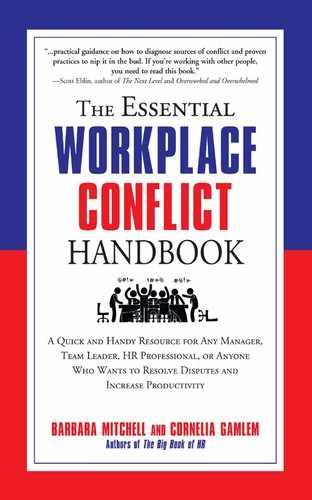NOTES
Introduction
1. Lynne Eisaguirre, The Power of a Good Fight (Indianapolis, IN: Alpha, A Pearson Education, 2002), p. xiii.
Chapter 1
1. Sharon Armstrong, The Essential Performance Review Handbook (Franklin Lakes, NJ: Career Press, 2010), p. 109.
2. Richard Y. Chang, Mastering Change Management (San Francisco: Jossey-Bass Pfeiffer, 1994), p. 5.
3. Lee Gardenswartz and Anita Rowe, Diverse Teams at Work (Alexandria, VA: SHRM, 2003), p. 133.
4. Susan Mulligan, “Wisdom of the Ages,” HR Magazine, November 2014, p. 24.
5. Patrick Lencioni, The Advantage (Hoboken, NJ: Jossey-Bass, 2012), p. 38.
Chapter 2
1. Marilyn Loden, Implementing Diversity (Burr Ridge, IL: Irwin Professional Publishing, 1996), pp. 14–15.
2. www.bls.gov/cps/demographics.htm.
3. www.forbes.com/sites/rawnshah/2011/04/20/working-with-five-generations-in-theworkplace/.
4. Elizabeth F. Fideler, Women Still At Work: Professionals Over Sixty and On the Job (Lanham, MD: Rowman & Littlefield Publishers, Inc., 2012), p. 46.
5. Douglas Stone, Bruce Patton, and Sheila Heen, Difficult Conversations: How to Discuss What Matters Most (New York, NY: Penguin Books, 1999), pp. 31–34.
6. Dana Wilkie, “Rooting Out Hidden Bias,” HR Magazine, December 2014, p. 25.
7. Steve L. Robbins, What If? Short Stories to Spark Diversity Dialogue (Mountain View, CA: Davies-Black Publishing, 2008), p. 75.
8. Robbins, p. 58.
9. Robbins, p. 82.
10. Robbins, p. xiii.
11. Stone, p. 176.
12. William Ury, The Power of a Positive No (New York, NY: Bantam Books, 2004), p. 82.
Chapter 3
1. Patrick Lencioni, The Advantage (San Francisco: Jossey-Bass, 2012), p. 21.
2. Lee Gardenswartz and Anita Rowe, Diverse Teams at Work (Alexandria, VA: SHRM, 2003), p 156.
3. Stephen Covey, The Seven Habits of Highly Effective People (New York, NY: Free Press, 1989), p. 248.
4. Lee Gardenswartz and Anita Rowe, Diverse Teams at Work (Alexandria, VA: SHRM, 2003), p 75.
5. Lencioni, p. 38.
6. Lencioni, p. 27.
7. Daniel Goleman, Working with Emotional Intelligence (New York, NY: Bantam Books, 2004), p. 219.
8. Robert Heller and Tim Hindle, The Essential Manager’s Handbook (New York, NY: DK Publishing, 1998), p. 363.
Chapter 4
1. Michael Watkins, Subject Advisor, The Essentials of Negotiations (Boston: Harvard Business School Press, 2005), p. 65.
2. Kerry Patterson, Joseph Grenny, Ron McMillan, and Al Switzler, Crucial Conversations, Tools for Talking When Stakes are High (New York, NY: McGraw Hill, 2011), p. 20.
3. Barbara Mitchell and Cornelia Gamlem, The Big Book of HR (Pompton Plains, NJ: Career Press, 2011), p. 198.
4. Perry Zeus and Suzanne Skiffington, The Coaching at Work Toolkit, A Complete Guide to Techniques and Practices (New York, NY: McGraw Hill, 2003), pp.164–165.
5. Patterson, Grenny, McMillan, and Switzler, p. 21.
6. Mitchell and Gamlem, p. 197.
7. Mitchell and Gamlem, p. 199.
8. Douglas Stone, Bruce Patton, and Sheila Heen, Difficult Conversations: How to Discuss What Matters Most (New York, NY: Penguin Books, 2010), pp. 12–13.
9. Stone, Patton, and Heen, pp. 18–19.
10. Kerry Patterson, Joseph Grenny, Ron McMillan, and Al Switzler, Crucial Confrontations, Tools for Resolving Broken Promises, Violated Expectations, and Bad Behavior (New York, NY: McGraw Hill, 2005), p. 34.
Chapter 5
1. Daniel Goleman, Working with Emotional intelligence (New York, NY: Bantam Books, 1998), p. 140.
2. Eisaguirre, Lynne, The Power of a Good Fight (Indianapolis, IN: Alpha Books, 2002), p.158.
3. Jennifer Nycz-Connor, Washington Business Journal, November 4, 2014, p. 54.
4. www.goodreads.com/quotes/633610-the-mostimportant-thing-in-communication-is-hearingwhat-isn-t.
5. Mitchell and Gamlem, The Big Book of HR, p. 198.
6. Mark Goulston, Just Listen: Discover the Secret to Getting Through to Absolutely Everyone, (New York, NY: AMACOM, 2010), p. 39.
7. Eisaguirre, p. 165.
8. www.brainyquote.com/quotes/authors/j/john_marshall.html.
Chapter 6
1. Kerry Patterson, Joseph Grenny, Ron McMillan, and Al Switzler, Crucial Conversations, Tools for Talking When Stakes are High (New York, NY: McGraw Hill, 2011), p. 108.
2. Patterson, et al., p. 119.
3. Patterson, et al., p. 128.
4. Mitchell and Gamlem, p. 190.
5. Ury, p. 68.
6. Mitchell and Gamlem, pp. 192–193.
7. Sharon Armstrong and Barbara Mitchell, The Essential HR Handbook (Franklin Lakes, NJ: Career Press, 2008), pp. 64–65.
8. https://hbr.org/2015/02/how-to-coachaccording-to-5-great-sports-coaches.
9. www.mindtools.com/pages/article/newLDR_44.htm.
10. Gary Seigel, PhD, The Mouth Trap (Franklin Lakes, NJ: Career Press, 2008), pp. 130–132.
Chapter 7
1. Roger Fisher and William Ury, Getting to Yes (New York: Penguin Books, 1991), p. 15.
2. Tim Ursiny, The Coward’s Guide to Conflict (Naperville, IL: Sourcebooks, Inc., 2003), p. 137.
3. William Ury, The Power of a Positive No (New York, NY: Bantam Books, 2004), pp. 30–31.
4. Rosamund Stone Zander and Benjamin Zander, The Art of Possibility (New York: Penguin Group, 2000), p. 15.
5. Fisher and Ury, pp. 85–86.
6. Ury, pp. 114–115.
7. Michael Watkins, Subject Advisor, The Essentials of Negotiations (Boston: Harvard Business School Press, 2005), p. 112.
8. Mitchell and Gamlem, p. 205.
9. Mitchell and Gamlem, p. 109.
Chapter 8
1. Mitchell and Gamlem, p. 219.
2. Eisaguirre, p. 58.
3. Mitchell and Gamlem, p. 220.
Chapter 9
1. Douglas Stone, Bruce Patton, and Sheila Heen, Difficult Conversations: How to Discuss What Matters Most (New York, NY: Penguin Books, 2010), p.150.
2. Mitchell and Gamlem, p. 230.
3. www.eeoc.gov/laws/types/sexual_harassment.cfm.
Chapter 10
1. http://www.eeoc.gov/laws/types/harassment.cfm.
2. Dennis A. Davis, PhD, “Bullying, Harassment, and Violence: What’s Atmosphere Got to Do With It?” Ogletree Deakins, The Employment Law Authority, October/November 2014, p. 4.
3. Davis, p. 4.
4. Tom Larkin and Jean Marie Johnson, “What’s in a Micro-Message?” www.communicoltd.com/pages/1017_are_microinequities_damaging_your_workplace_.cfm.
5. Patterson, et al., p. 98.
6. www.bullyingstatistics.org/content/workplacebullying.html.
7. Davis, p. 5.
8. Beverly Langford, The Etiquette Edge (New York, NY: AMACOM, 2005), p. 35.
9. Langford, p. 40.
10. http://www2.ucsc.edu/title9-sh/intent.htm.
11. Stone, et al., p. 46.
12. Stone, et al., p. 53.
Chapter 11
1. Mitchell and Gamlem, p. 171.
2. Mitchell and Gamlem, p. 209.
3. Mitchell and Gamlem, p. 209.
4. Mitchell and Gamlem, p. 210.
5. Mitchell and Gamlem, p. 208.
6. Mitchell and Gamlem, p. 229.
7. Scott Eblin, Overworked and Overwhelmed (Hoboken, NJ: John Wiley & Sons, Inc., 2014), p. 8.
8. Eblin, p. 18.
9. Mitchell and Gamlem, p. 158.
10. Mitchell and Gamlem, p. 106.
